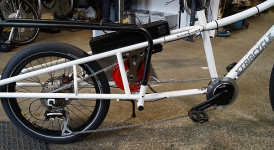To an extent, if you squint just right, my approach on my trike (3d link in my signature) does some of this.
As designed, the trike has a conventional 'chain-on-the-right' spanning from the cranks at the front to the cassette on the rear wheel. There happens to be an idler to support the chain in it's journey (past the cross-arm).
I kept the existing idler and added a second beside it to guide both the power and return chain runs under the front cross-arm, but I moved the cassette from the rear wheel to a motor mounted behind the seat and above the frame. As it happens, there are straight chain runs from the idlers to the top of the cluster (power run) and from the bottom of the derailleur arm to the second idler (return run)
The power from my pedaling and the motor together exits from the left side of the motor casing into a Gates belt drive from a sprocket mounted to the 6 bolt ISO brake rotor pattern (instead of a brake rotor on the motor) and is transmitted to the rear wheel/hub to a corresponding Gates sprocket also mounted where a brake rotor would be. With many tadpole trikes, there is no utility to a rear wheel brake as the two front brakes can easily lift the rear tire, although I have seen rear brakes added as parking brakes.
The motor in fact serves as a regenerative brake, so I do have a brake on the rear motor and in most cases it is sufficient to bring the trike to a stop by itself, although I can still grab the two mechanical brakes on the front wheels when needed.
Regeneration won't work so simply with a chain-and-idler so the Gates belt provides a long-lived replacement under constant tension (and it does not care about the weather). The front chain circuit is entirely conventional apart from the cassette/motor not being in the rear wheel, and the idlers to conduct the chain under the cross-arm. The cassette has the normal freewheel function.
On electrical failure, I have the full set of 'gears' (ratios) and the only drawback is the extra weight of the electrics plus some motor 'cogging' (internal magnet resistance).
On rider failure, I have the electric motor to take me home, and for that matter, up steep hills with cargo. I am optimising the trike to haul loads, and I have selected the sprocket on the motor and the sprocket on the rear wheel to drop the overall gearing without needing a very large cassette, reducing my derailleur needs and avoiding dragging the derailleur through the mud.
I don't see a way to use an internal gear hub on the rear as the input sprocket for those are on the right. I would need to add a 'jackshaft' to transmit the motor output (belt) from the left side to the right. I can imagine using an internal gear hub where I currently have the motor mounted and then having the same ISO rotor mount sprocket connecting to a corresponding one on the left side of a motor in the rear wheel, and as the motor pushes against its torque arm I think I would still realise a summation of my pedal input and the motor power, but I like not having the motor in the rear wheel - it's further out of any water or sand mounted up behind the seat and easier to change a flat tire.
I have also considered that I could replace the cassette/motor with a cassette and conventional rear axle and all would work as they do now without the benefit of the motor boost. I want the motor boost, but this is an option in some extreme circumstances (waiting for a slow boat with a replacement motor perhaps).
I am currently working out a new motor cradle to fit a Grin All-Axle V3 with a torque sensor. The original GMAC could easily power me and cargo up steep hills, and the current SX2 is marginal. I expect the All-Axle to measure up to the GMAC with a sprocket ratio change I have made - supplying power beyond 25km/hr is illegal in Australia, so not of interest to me.


